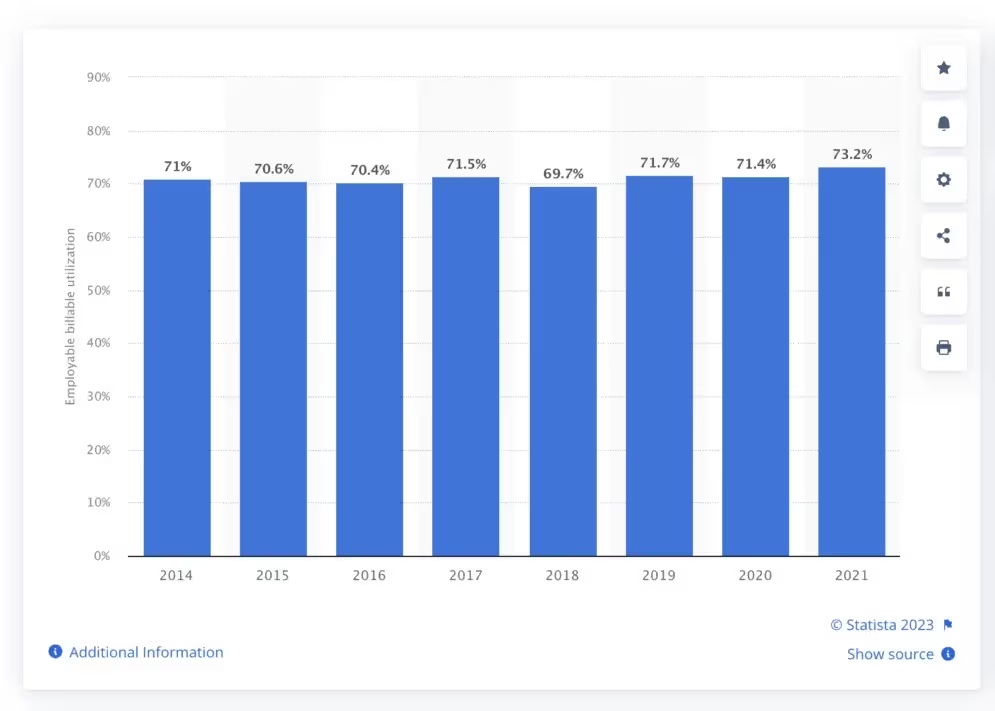Billable vs. Non-Billable Hours: Differences & Strategies
Learn how to make the most of your agency time by exploring the differences of billable and non-billable hours (and which to prioritize at what time!).




Have you ever wondered why your agency isn’t making profits despite seemingly endless meetings, emails, and brainstorming sessions?
Business operations are often oriented towards creating quality deliverables and achieving client goals.
However, many activities aren’t connected with deliverables at all.
On average, an employee spends almost half of their working hours on these unavoidable tasks.
But you can’t bill your client for these, even if a good chunk of resources goes into it.
Agency owners are always juggling to clearly distinguish between billable and non-billable hours.
A lack of clarity on this can result in inaccurate invoicing and revenue loss.

This guide will help you understand the difference between billable and non-billable hours, how to calculate them, and ways to optimize your non-billable hours.
The main difference between billable and non-billable hours is the hours spent working on a client’s project. Many companies, including agencies, independent consultants, and contractors, operate at an hourly rate. They track the time spent on a project and bill it to the client.
Billable hours are the hours your team spends working on a client project.
These are the number of hours that are billable to the client on the agreed hourly rate.
To avoid any confusion, billable tasks are usually outlined in a contract between you and the client.
Tracking billable hours isn’t just important for billing clients but also for avoiding free work and for determining the efficiency and profitability of projects.
No matter how you track your billable hours, it's always advised to estimate how much time you will spend on a project before signing a contract.
This will help you set a fair price for your work and reach your target billable hours.
Here are some examples of billable hours:
The existence of billable hours doesn’t negate the value of non-billable hours.
Looking for clients, managing smooth operations, or finding people who can efficiently do client work requires a certain number of hours that can’t be billed.
Non-billable hours refer to the number of hours dedicated to activities that are essential for the smooth functioning of the agency.
These hours also include activities that agencies do for their own benefit, such as organizing team-engaging activities, taking breaks to freshen up, or eating.
Here are some examples of non-billable hours:
It’s simple to figure out how many billable hours you have worked and multiply it by your hourly rate. However, as an agency, when you have a diverse team working on a project that is paid differently, and you need to account for all those different rates, issues start to surface.
Here’s a step-by-step method that your agency can use to calculate billable and non-billable hours:
Start with figuring out how many working hours your employees have in a year.
The majority of employees work 40 hours a week, and there are 52 weeks in a year.
40 hours/week x 52 weeks/year = 2,080 hours/year
Let’s say your agency offers paid holidays and sick leave.
That’s 30 days of paid time off, or 240 hours in total.
2,080 hours/year – 240 PTO hours/year = 1,840 available work hours/year
That means one of your employees is available for 1,840 working hours/year.
The agency utilization rate is a benchmark that signifies how efficiently an agency’s workforce has been utilized.
It gives a clear picture of time spent on revenue-generating tasks compared to non-billable activities.
Calculating agency utilization rate is pretty straightforward.
Simply divide your team member’s billable hours by the total number of working hours (billable non-billable working hours).
You can just use this formula:
Agency utilization rate= (Total billable hours/ Total Number of Working Hours) x 100
Let’s take a 70% utilization rate and our total available hours from the previous section.
0.70 utilization rate x 1,840 available work hours/year = 1,288 billable hours/year
Now, we have our key number of total billable hours.
Every agency will have different standards for what they consider their best utilization rate.
However, according to Statista, the ideal utilization rate for a healthy team would be 75%.
This keeps the team working efficiently without having to feel burnout.

Now, you might think that having a utilization rate near 100% means your employees spend all of their time on client-specific tasks.
But that’s not really a good thing.
It’s likely your team is overwhelmed and at risk of burnout.
Eventually, burnout leads to lower employee engagement, absences, and turnover.
Overutilisation also leads to quality issues.
Your team feels emotionally exhausted and doesn't have enough time to showcase creativity.
Forcing people to complete certain billable hours for a higher agency utilization rate is not at all recommended.

A low agency utilization rate means that you’re not bringing in enough projects.
Employees are sitting around the office doing nothing.
Underutilized resources don’t deliver ROI.
They cost your agency and indicate lower productivity among employees.
That being said, every employee’s task is different. Some months you might see them working for the business and some for the employees.
A balance of billable and non-billable hours is the key to running a successful business and engaging employees.
Now, calculate your agency’s business cost, which includes employee salaries, overhead cost, and target profit margin.
A simple trick for calculating business expenses is to multiply the employee’s salary by 3. Why did we use the number 3, especially?
According to Gallup,
“The cost of replacing an individual employee can range from one-half to two times the employee's annual salary.”
So, we multiply the employee’s salary three times to cover the replacement cost, profit, and any other unforeseen costs.
Let’s say the employee’s salary is $70,000; now multiply it by 3.
$70,000 salary x 3 = $210,000 business cost
Now comes the last step: calculating the billable hourly rate.
Divide your business cost by the number of billable hours you will need to calculate your billable rate.
Business cost / billable hours = billable rate
In this example, we had 1,288 billable hours and a $210,000 business cost.
$210,000 business cost / 1,288 billable hours = $163 per hour
Remember that your billable hourly rate can vary depending on your agency’s utilization rate, salaries, overhead costs, and profit.
As your team grows, overhead costs increase, and growth becomes a priority—the need to have visibility into the future becomes crucial.
Keeping your billable hours high means reducing your non-billable hours to an extent that doesn’t affect work quality and employee engagement.
Here are a few ways you can adopt to reduce your non-billable hours:
Agencies often struggle with a lack of standardization in internal processes, and team members may have different interpretations of what is billable or non-billable.
For instance:
There is no universal rule regarding what you can charge.
However, the lack of standardization leads to inconsistencies.

Solution:
A report from FastPay says 62% of invoices take over 90 days to be paid at an agency, and 94% take more than 30 days to be paid.
While you will eventually be paid, the back-and-forth will cost you valuable time.
Set up a comprehensive document that clearly documents billable and non-billable hours.
Write clear and consistent definitions of billable and non-billable hours according to your agency.
Add instructions on how to specify a certain task into each of the categories, including instructions on how to account for specific hours/requests.
Share this document with your clients as well so they are well-informed about the tasks they will be billed for. This will remove any inconsistencies in the billing process and eliminate the need for unnecessary meetings or email threads about why you have billed what you have billed.
On average, employees spend 18.9 hours per week on non-billable tasks, which accounts for 907 hours every year or almost 38 days.
The loss of resources on non-billable tasks can be an agency's biggest liability.
So, what can you do to reduce your non-billable hours?
Outsourcing to specialized individuals or agencies.

Solution:
A huge chunk of the agency's non-billable hours includes marketing initiatives, customer service, cold-calling, or tasks that don't require in-depth brand knowledge.
The majority of these tasks can be easily outsourced to specialized third-party freelancers or agencies.
An independent contractor works as an external agent that helps agencies receive the resistance they need without having to hire an in-house team to pull internal resources.
Outsourcing gives access to talented people who have been verified to perform certain tasks.
These people are more likely to have worked on projects that require similar skills and are confident about what they can deliver.
You can find individual contractors and agencies by asking for referrals or searching sites like Linkedin, Upwork, or Fiver.
The answer to both maximizing quality and minimizing the time spent on non-client tasks is automation.
Automation creates a system where tasks are done on their own, cutting off a few non-billable minutes here and there.
These are some of the non-billable tasks that can be easily automated:
Research has shown that businesses that don't use time management lose over $18,000 on average every year.
If implemented correctly, time tracking will help your agency be more efficient and transparent to both team members and clients.
The best way to track your employee’s working hours is by using dedicated time-tracking software.
Why most people hate time-tracking is because it's probably the most dreaded task at the end of the day, and you just want to go home.
The good thing is that time-tracking software eliminates all these excuses.
Unlike time-tracking Excel spreadsheets, where employees have to constantly fill up all the information, time-tracking software does it for you.
From live reporting to payroll management, time-tracking software helps agencies significantly cut down their non-billable hours spent on tracking and invoicing clients.
The main takeaway is that both billable and non-billable hours are important.
While billable hours generate revenue, non-billable hours are crucial for long-term business maintenance.
If you are looking for dedicated time-tracking software made for agencies, ManyRequests is for you.

It helps you get a birds-eye view of how much time your employees are spending on projects.
With a powerful client portal that links projects directly to time spent on each task, agencies like yours see up to a 4x increase in productivity.
Sign up for free!